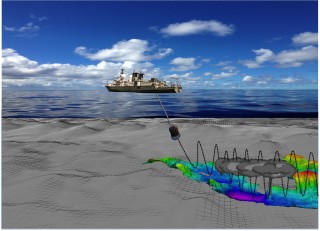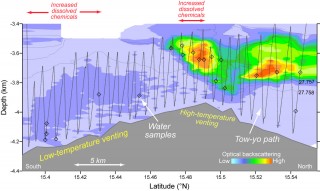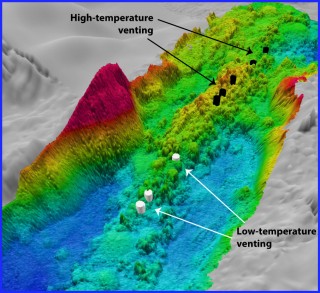Like a bloodhound on the scent, the recent discovery of our first new vent site energized our exploration efforts. Our next target site was on Map 5, which shows two shallow “saddles” separated by deep basins.

These high points correspond to places along the Mariana Back-arc where an enhanced supply of molten magma over hundreds of thousands of years has constructed a volcanic landscape. More magma means more heat, and heat drives hydrothermal venting. Our CTD tow-yo survey of the southern high, near 15°5’N, came up empty several days ago. On December 2nd we targeted the volcanic ridge centered near 15°30’N in the northern half of Map 5 with another CTD tow-yo. As our blog on the betting pool advised, “That one has potential.”
More plumes! And they are big!

Yesterday we turned that potential into plumes. More plumes than anyone imagined, all visualized by doing a CTD tow-yo stretching for 17 km up and over the volcanic high. Even more exciting— if that’s possible —is our discovery that two very different kinds of hydrothermal venting occur in this one area. Along the southern half, we found very intense signals from our ORP chemical sensor but surprisingly weak response from the optical backscatter sensor that measures suspended particles. This combination means that the temperature of the venting fluid is probably less than 100°C, too low to supply the dissolved metals (such as iron) that form the famous “black smoke” that geysers from high-temperature vents. Although this type of venting – called “diffuse” because no vent chimneys focus the flow – might disappoint photographers, it is immensely popular with animals trying to survive on the seafloor. Our observations suggest that this diffuse field is active over almost 10 km, supplying a chemical bath that supports the vent ecosystem but lacking the menace of life-ending 350°C temperatures.
One of the deepest vent sites ever found!

We also came close to a Guinness World Record on this tow-yo. Of the almost 700 known vent sites around the world, only three are known to be deeper than the venting we detected at ~4230 m! If we had Guinness on board we’d be toasting ourselves! Those spectacular high-temperature vents must lurk around the summit of the saddle, as plumes above that area have far higher values of optical backscattering than to the south. How do we know where those vents might be? ORP anomalies occur only close to their source, within a kilometer or two, and we detected significant ORP anomalies only within the high-rising plume above the summit. The plumes at the farthest north had very low ORP values. This tells us they are older than the plumes just above the summit, having drifted north with the local water currents as new plumes take their place.
Discovering two completely different kinds of vent fields so close to each other opens intriguing research possibilities. For example, how will the biology change between each field? We will examine that question fully next year when we return with a remotely operated vehicle to image and sample the seafloor environment. But for now, the Sentry AUV is cruising methodically at 5 m above the seafloor, snapping pictures of a patch of seafloor where we suspect diffuse venting is most active. Look for those pictures in another blog post here soon!

